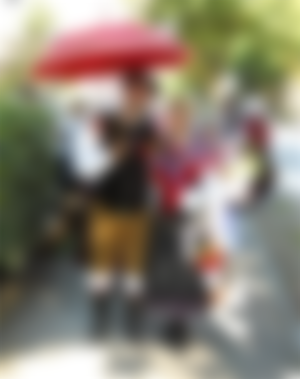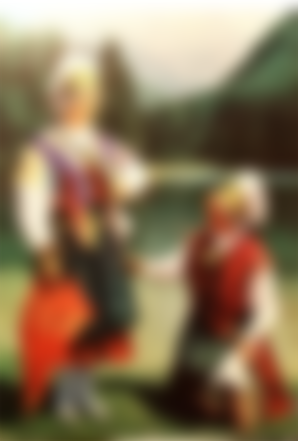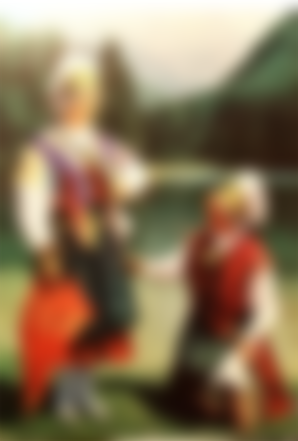One of the components of our heritage are national costumes. They arose over long periods of time and for a variety of reasons. Thus, the costumes began to differ in form and other dimensions. The national costume forms the national identity of the Slovenes, so we must cultivate, preserve and protect it for our descendants as well.
Slovenian traditional national costume was formed in the second half of the 19th century. During the camp movement, Slovenes were in favor they chose their costume from the surroundings of Bled and further embellished it.
According to the protocol, the national costume was the most formal attire, ranked much higher scale of importance as an ordinary dress.

MEN'S NATIONAL COSTUME:

Men's costumes include a black hat on which the "culprits" boast. These are dwarf feathers that have made the boys even fight in the past. The front part of the leibč (vest) is made of velvet with imported flowers (but this is not a condition), and the back is made of klot. Other types of goods, silk and wool, also appeared. It closes at the front with a whole range of metal (chrome or richer silver) buttons. Under the vests, however, the men even wore a silk scarf, which was seen very little on the shoulder, and the emphasis was on the front under the neck. In the lower part of the leib, a necklace is attached to the buttonhole, which reaches into the pocket. A gold or silver pocket watch is attached to the end of the necklace. Quality trousers (irharce) are made of deer or chamois leather. Above all, they must reach over the knee. They can be on a belt or with the addition of braces. They are fastened with metal buttons or with buttons made of horn. Under the vest is a white heavily pleated linen shirt, and under the trousers are long cotton underpants. Wool socks in a natural wool color can also be worn. In the Upper Gorenjska region, blue wool socks are worn. When combined with socks, shoes that reach over the ankle are worn. Alternatively, there are black leather boots that reach to the middle of the thigh, or folded back below the knee, lined with red leather (in some places this edge is black), and patterns on the upper. Men can also wear a cotton apricot, it is in a red color called Kranjska marela. It is mainly used to protect against the sun's rays, but it also retains some rain.
WOMEN'S NATIONAL COSTUME:


The women's costume consists of a long silk dress, which can be of different colors (blue, green, red, brown, gray), a silk scarf, a silk black apron and sleeves. they spread when we bend our arms. The girls wore a silk scarf a little above the waist and added fresh, red cloves. On the right side of the belt, right at the side, they wore a nicely folded handkerchief lined with lace. Under the dress they wore two very gathered long lower skirts (untari) to make them look more abundant and thus also richer. The more they had, the more affluent they were and therefore desirable. Socks with bumps, which optically thickened the leg, also contributed to this. Around their hips they wore a metal belt (knuckle) with a ribbon, a bandage on their head, and married avbo or stove.
After the First World War, the national costume began to lose its significance as a symbol of national affiliation and consciousness due to many, including political, factors. She was only dressed at some gatherings and parties, church events and protocols.Looks like a real costume from previous centuries. Our clothing tradition is much richer and it is right that we nurture it and revive it in its originality. The national costumes are most strongly represented among Slovenes in Argentina, where they also take professional care of its preservation.
With its attractiveness, it has also gained the importance of a tourist attraction in our country. However, so changed, it only
In Slovenia, many national-entertainment ensembles also use the Slovenian national costume as their clothing.
Today, the national costume does not represent anything to the vast majority of Slovenes. Saccession to the European Union, so that the numbers of our distinguishing marks are defeated and between them also the national costume they once wore with such pride. When we look, for example, nationally entertainment shows, the costume is presented as part of "show business", it may already be a subject in some places mockery, saying - ‘again this beef music’.
Of course, there are exceptions, which fortunately are still quite a few. Folklore societies are,especially lately, they are very committed to bringing people back to this part of the culture that we are in the period of progressive capitalism and by changing political regimes pushed it to page. The real costume still lives on in the memories of the oldest citizens who still remember,how mom put an abba on her head and went so dressed for a wedding or celebration. That would be us nowadays it probably seemed unimaginable. For our people's history not to be forgotten,there are also ethnographic museums, which keep many examples of costumes from different periods, and many written and oral testimonies.
Thank you for reading my post.
I wish you Happy Sunday!
ENJOY!!!!




The national costume is part of the tradition, a feature of the national culture, but unfortunately it is too neglected ... Three years ago, when my brother had a wedding, the sons-in-law wore the national costume at his wedding ... I can't describe the enthusiasm of the guests ...